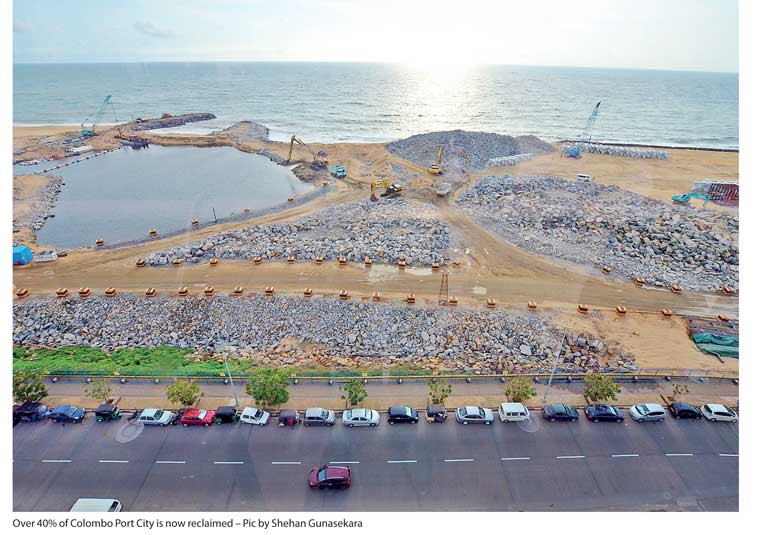Thursday Mar 13, 2025
Thursday Mar 13, 2025
Wednesday, 7 June 2017 00:00 - - {{hitsCtrl.values.hits}}
 By Jones Lang LaSalle
By Jones Lang LaSalle
Property Consultants
There is ample evidence to support Sri Lanka’s importance and strategic location, between East and West, during the period when the ancient Silk Road operated from China to Europe providing land and sea routes for the movement of silks, spices and precious stones. Archaeological excavations have revealed troves of Roman and Chinese coins that prove sea faring merchants of the time ventured to, what is now known as Sri Lanka, to exchange goods and barter for wares.
Since becoming the world’s second largest economy, China’s bold One Belt, One Road (OBOR) initiative, first announced in 2013, has become the cornerstone of China’s economic diplomacy and has put Sri Lanka firmly back on the maritime trading map. This contemporary reincarnation of the ancient Silk Road was articulated in a document released by the Chinese Government in 2015 entitled ‘Visions and actions on jointly building Silk Road Economic Belt and 21st Century Maritime Silk Road,’ outlining strategy to connect the Asian, African and European continents and to strengthen partnerships with countries along the belt and road, towards promoting diversified, independent, balanced and sustainable development.
Of particular significance to Sri Lanka is the Maritime Silk Road linking China’s coastal cities to Africa and Europe via the South China Sea and Indian Ocean. Sri Lanka’s strategic position, bridging east and west on the new Maritime Silk Road offers the opportunity to re-establish and promote the country as a key trading hub in the Indian Ocean, with obvious benefits to commerce and business throughout the island nation.
China’s trade with nations along the Maritime Silk Road, over the past decade, has been growing at an astonishing average annual rate of 18.2% and China has already invested over $ 8 billion in Sri Lanka with an additional $ 24 billion of potential future investment recently announced when Prime Minister, Ranil Wickremesinghe attended an OBOR forum for global leaders, hosted by the Chinese Government.
In addition, work has recently restarted on the Chinese funded $ 1.5 billion Colombo Port City, a 270-hectare master planned land reclamation project, that will transform the real estate market in Colombo, and talks are well advanced between the two countries to restructure the $ 1.4 billion loan granted to Sri Lanka, by China, to develop Hambantota Port.
This frenetic activity has heightened geo political sensitivities in the region, with India expressing suspicions over Chinese military ambitions, amongst other concerns, leaving Sri Lanka to carry out a delicate balancing act between the interests of its nearest geographical neighbour and traditional trading partner, India, and its largest economic investor and provider of much needed infrastructure, China.
Historically, freedom of navigation across the Indian Ocean has been the catalyst for economic growth and prosperity in the region and, as India belatedly expands its interests in Sri Lanka, it is hoped that economic priorities outweigh military considerations.
The keys to Sri Lanka’s future prosperity and the island’s real estate ambitions are transport infrastructure and security of utility provision, both heavily reliant on Chinese investment, as part of the OBOR strategic initiative.
The sea ports of Colombo, Hambantota and Trincomalee and the international airports, Colombo and Mattala, are to be linked to special economic zones (SEZ) by road and rail, creating corridors of potential land price growth which is already attracting speculative real estate investment activity.
China is also pushing for 15,000 acres of land to be granted to them and designated as a SEZ, on the promise of up to 1,000,000 jobs being created and there are hopes that a Sino-Sri Lanka Free Trade Agreement (FTA) can be ratified in 2017.
With over 40% of Colombo Port City now reclaimed, notice is beginning to be taken in this ambitious project and JLL is actively involved in negotiating expressions of interest from Chinese, Indian, Malaysian and Singapore based investors/second tier developers, while local development companies and investment institutions are also jockeying for position.
The existing Colombo central business district (CBD), Colombo 01 and 02, might also come under pressure from the creation of Colombo International Financial City (CIFC) with Free Zone status on Colombo Port City and China Harbour Engineering Company, the Government’s joint venture partners in the project, are demonstrating their confidence in the overall project by developing a mixed use pilot scheme with residential, retail, commercial office and hospitality components.
With a proposed light railway transport system, open spaces, parks and squares, cultural, health and education amenities, plus a world class marina, Colombo Port City is just one visible benefit to Sri Lanka of the new Maritime Silk Road and it is hoped that there may yet be many more to be revealed.
Discover Kapruka, the leading online shopping platform in Sri Lanka, where you can conveniently send Gifts and Flowers to your loved ones for any event including Valentine ’s Day. Explore a wide range of popular Shopping Categories on Kapruka, including Toys, Groceries, Electronics, Birthday Cakes, Fruits, Chocolates, Flower Bouquets, Clothing, Watches, Lingerie, Gift Sets and Jewellery. Also if you’re interested in selling with Kapruka, Partner Central by Kapruka is the best solution to start with. Moreover, through Kapruka Global Shop, you can also enjoy the convenience of purchasing products from renowned platforms like Amazon and eBay and have them delivered to Sri Lanka.
Discover Kapruka, the leading online shopping platform in Sri Lanka, where you can conveniently send Gifts and Flowers to your loved ones for any event including Valentine ’s Day. Explore a wide range of popular Shopping Categories on Kapruka, including Toys, Groceries, Electronics, Birthday Cakes, Fruits, Chocolates, Flower Bouquets, Clothing, Watches, Lingerie, Gift Sets and Jewellery. Also if you’re interested in selling with Kapruka, Partner Central by Kapruka is the best solution to start with. Moreover, through Kapruka Global Shop, you can also enjoy the convenience of purchasing products from renowned platforms like Amazon and eBay and have them delivered to Sri Lanka.